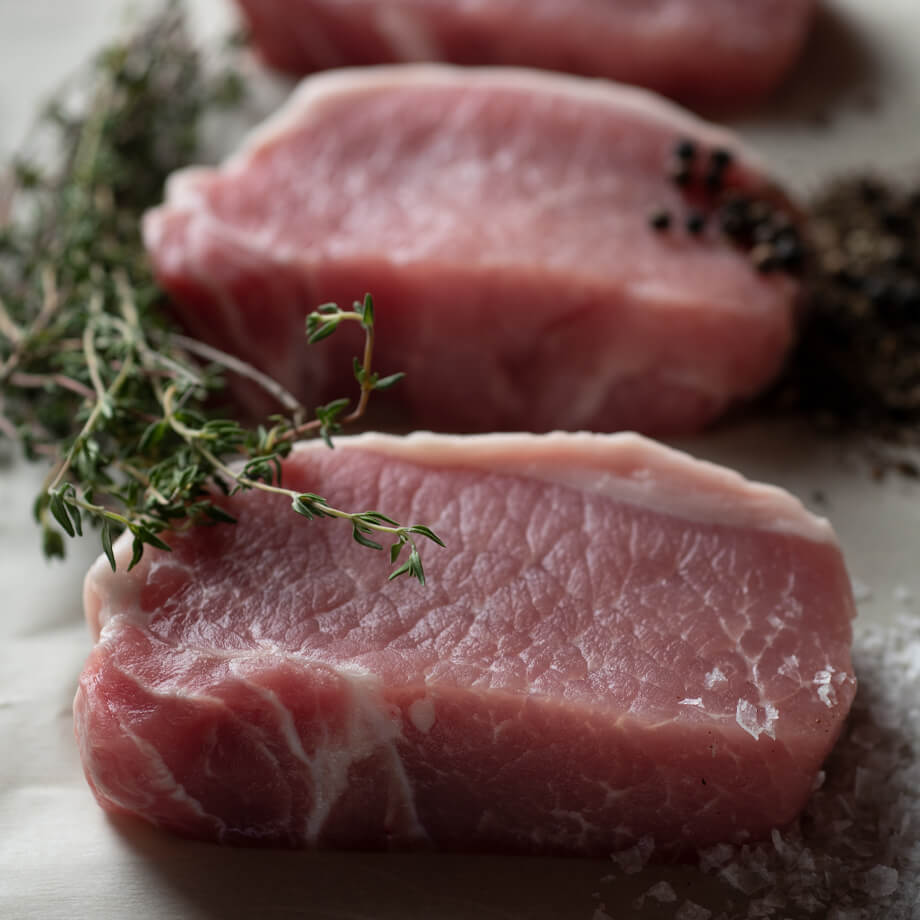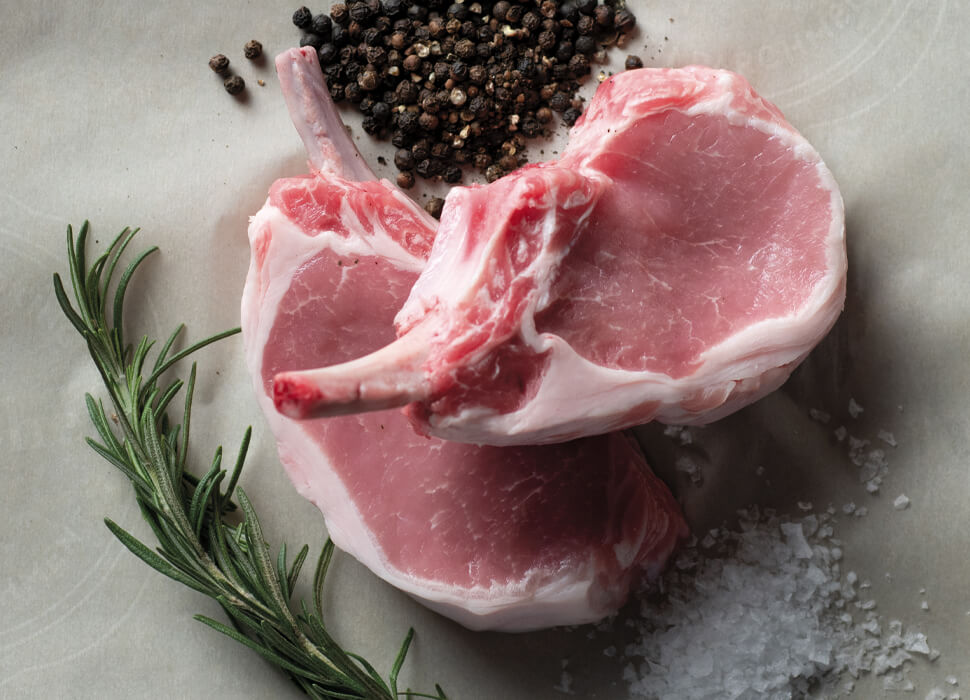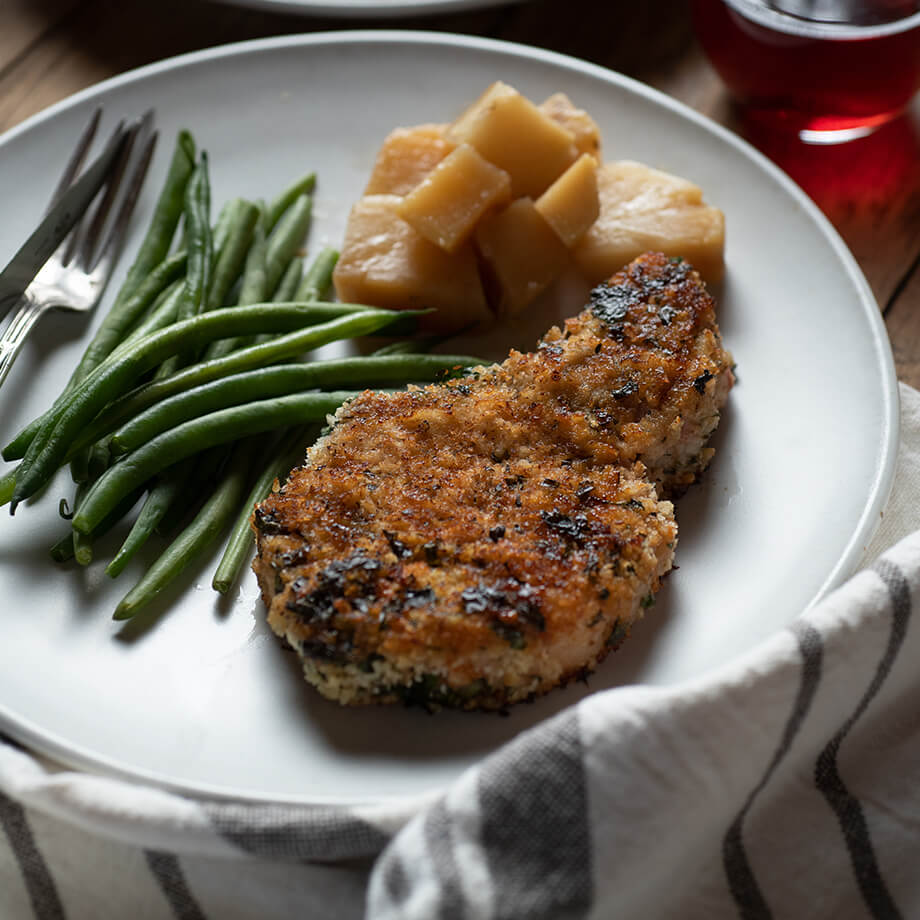As an affordable, lean protein, chicken gets a lot of love on weeknights. But pork chops make an outstanding alternative when you’re looking for something healthy and versatile!
There’s no end of options to what you can whip up with these tasty chops. Sprinkle them with herbs, or smother them with a rich pan sauce. Top them with sauteed mushrooms, or grill them for an easy summer meal.
If you’re a bit confused or intimidated by the different cuts available, we’re here to help. Read on for a quick education on pork chops, the pros and cons of each cut, and some helpful cooking tips to make dinner a breeze.
Bone-in Pork Chops
There are two primary cuts of bone-in pork chops — rib cut and center cut.
Rib cut pork chops include a rib bone and a medallion of lean loin meat. There is also usually some fat that helps connect the meat to the bone.
Center cut pork chops (also called the loin chop or center loin chop) include that same rib bone and the same loin meat. But on the other side of the bone is another piece of meat — a richer, darker piece of tenderloin. This additional meat means center cut pork chops are usually larger and may be more expensive than rib cut.
If you’re looking for a beautiful presentation, ask your butcher or meat counter to “French” your bone-in pork chops. This involves removing the meat from the exposed bone for a high-end, professional look.
Pros of Bone-In Pork Chops
- Great flavor. The bone and fat in these cuts provides extra flavor and releases moisture, which can prevent chops from getting dry.
- Appealing presentation. The bone looks lovely and professional, especially when Frenched!
- More affordable. This type of cut with the bone left in is typically less expensive. Keep in mind that if you get the chops Frenched as mentioned above, the careful butchering required can increase the price.
Cons of Bone-In Pork Chops
- Less meat. The bone and higher fat content mean each chop has less edible meat. But what you get may be more flavorful!
- Fattier cuts. If you prefer your meat cuts leaner, or don’t like to do the work to cut around the fat, this may deter you from a bone-in option.
- Longer cooking time. Bone-in chops take a little longer to cook, but since they’re typically cut thin, they can still be on the dinner table quickly.
- Harder to find. Bone-in options may not be pre-packaged with the rest of the meat, so you might need to pay a visit to your grocer’s meat counter or a butcher to find them.
Boneless Pork Chops
Boneless pork chops consist of the same meat as the rib-cut pork chop, but they have the bone and excess fat removed. Since these chops are trimmed and ready to cook, they’re perfect for quick weeknight dinners.
Pros of Boneless Pork Chops
- Ultra convenient. Boneless chops are ready to go right out of the package. And since they cook through quickly, you can have dinner on the table in minutes.
- More meat. There’s no waste on a boneless pork chop, and you don’t have to pay for the weight of the bone or fat. You get what you see in a boneless chop and can better gauge serving sizes.
- Leaner cuts. Because the fat and bone have been trimmed away by a butcher, the pieces are leaner and require less work to get “to the meat of it!”
- Easy to find. Boneless pork chops are available pre-packaged in nearly all grocery stores.
Cons of Boneless Pork Chops
- Can dry out. Without the bone and fat to impart moisture, boneless chops can dry out. You can avoid this with a quick cooking method like grilling, pan searing, or broiling. And keep a trusty meat thermometer nearby so you can gauge precisely when the meat is done.
- Some say less flavor. Personally, we think with the right recipe and technique, a boneless pork chop can be incredibly flavorful. But some believe they have less flavor than the bone-in version, which is likely due to lack of bone and fat.
Pork Chop Cooking Tips
If you’re new to the world of pork chops, use these tips for a delicious, flavorful result.
Before Cooking
To prevent your pork chops from drying out, marinate or brine them to get more moisture into the meat before cooking. Even a quick 30-minute marinade can help.
Season well before cooking. Since pork chops are very mild on their own, salting them before cooking will bring out the pork’s natural flavor.
Finally, let your pork chops reach room temperature before cooking. This will reduce overall cooking time and help prevent dryness.

While Cooking
Pick a method that cooks your chops quickly like grilling, pan-searing, or broiling. The faster the chops cook, the less moisture you’ll lose. To get a nice crust on the outside, you can sear your chops over high heat, and then let them finish in the oven.
Whether you choose bone-in or boneless pork chops, cook them to an internal temperature of 145°F to reach a perfect medium. Use an instant-read digital thermometer for an accurate reading. Always insert the probe at the thickest part of the meat, and make sure it’s not touching the bone.
After Cooking
It’s always a good idea to let meat rest for a few minutes before cutting into it. This lets the juices re-absorb into the meat, keeping it tender and moist. If you cut into your chops too soon, the juices will run onto your cutting board instead of staying inside.
Since pork chops are small, a rest time of about 10 minutes should do. You can tent some aluminum foil over the meat while it rests to keep it warm.
Get Cooking!
Ready to dive into the world of pork chops? Here are a few recipes from Coleman Natural to get you started:

